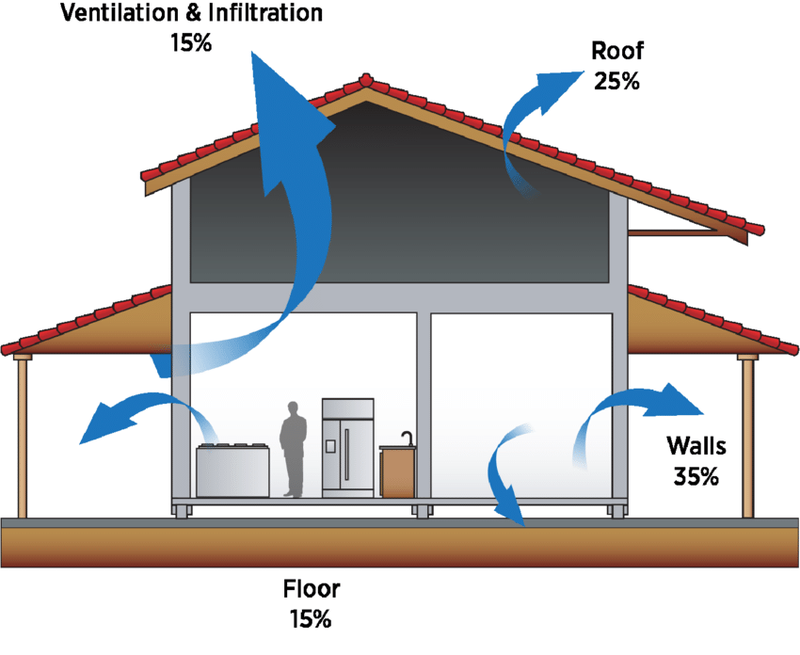Load calculations determine the heating and cooling requirements of a building by factoring in elements like insulation, climate, and occupancy. Accurate load calculations are essential for sizing HVAC systems correctly, preventing unnecessary waste, and keeping occupants comfortable. While manual load calculations have been
What Are HVAC Load Calculations?
HVAC load calculations are essential for determining a building’s heating and cooling needs. They take into account factors like insulation levels, window sizes, occupancy patterns, and local climate conditions to gauge the structure’s overall thermal load.
Load calculations are typically split into two main categories: cooling load calculations and heating load calculations.
Cooling Load Calculations
Cooling load calculations measure how much heat must be removed from a building to keep indoor temperatures comfortable in warmer weather. These calculations look at key sources of heat gain, including:
- Solar radiation through windows and walls
- Internal heat from occupants, lighting, and equipment
- Heat transfer through the building’s exterior
By accurately calculating the cooling load, HVAC contractors can choose the right air conditioning system and ensure optimal performance.
Heating Load Calculations
Heating load calculations determine how much heat must be added to a building to reach a desired indoor temperature in colder conditions. Key heat loss factors include:
- Heat transfer through walls, windows, and other exterior components
- Air infiltration and required ventilation
- Internal heat gains from occupants and equipment
Reliable heating load calculations help contractors select a system that can maintain a comfortable indoor environment during winter months.

Proper load calculations are crucial for selecting the right HVAC equipment size and capacity, ensuring optimal energy efficiency, and providing a comfortable indoor environment for occupants.
Why Accurate Load Calculations Matter
Cost Savings and Efficiency
Properly sized HVAC systems help reduce utility bills and avoid unnecessary energy use. The U.S. Department of Energy notes that correctly sized equipment can save homeowners up to 30% on costs. According to a study cited by the National Renewable Energy Laboratory (NREL), proper HVAC system sizing can lead to significant energy savings. In a hypothetical 2,000-square-foot home, implementing energy efficiency upgrades and right-sizing the HVAC system resulted in a reduction of the design heating load from 46,100 Btu/hr to 21,300 Btu/hr, and the design cooling load from 52,100 Btu/hr to 23,300 Btu/hr.
This represents a reduction of over 50% in both heating and cooling loads, demonstrating the substantial energy-saving potential of properly sized HVAC systems. Additionally, the Air Conditioning Contractors of America (ACCA) Manual J is the industry standard for residential load calculations, ensuring that HVAC systems are neither undersized nor oversized for optimal energy efficiency and indoor comfort.
Enhanced Comfort
Accurate load calculations ensure consistent indoor temperatures, eliminating hot or cold spots. This boosts customer satisfaction and helps foster trust and long-term client relationships.
Reduced Callbacks and Rework
When a system is sized correctly from the start, contractors avoid expensive do-overs or early replacements. Oversized units drive up installation costs and can short cycle, while undersized systems struggle to meet comfort demands. Both scenarios result in dissatisfied customers and lost revenue.
Code Compliance and Professional Credibility
Many local regulations require load calculations that meet established standards. Staying in compliance not only helps avoid penalties but also demonstrates a commitment to quality workmanship—reinforcing your reputation in the market.
Common Challenges in Manual Load Calculations
Performing HVAC load calculations manually is a time-consuming and error-prone process that often leads to customer dissatisfaction. Contractors frequently face these challenges due to reliance on outdated tools and methods that fail to keep up with the demands of modern HVAC projects.
One of the primary issues with manual load calculations is the sheer amount of time required to gather measurements, input data, and crunch numbers. This tedious process can take hours or even days, depending on the complexity of the project. As a result, contractors may face delays in project timelines, leading to frustrated customers and potential revenue losses.
Moreover, manual calculations are susceptible to human errors, such as miscalculations, incorrect data entry, or overlooked variables. Even a minor mistake can result in an improperly sized HVAC system, leading to inefficient energy consumption, compromised indoor comfort, and potential system failures. These errors not only impact customer satisfaction but can also damage a contractor's reputation and lead to costly callbacks and rework.
Compounding these issues is the challenge of effectively communicating load calculation results to homeowners. Without visual aids or user-friendly reports, it can be difficult for customers to understand the rationale behind HVAC system recommendations, leading to confusion, distrust, and potential project delays or cancellations.
Many contractors continue to face these challenges due to a reluctance to adopt new technologies or a lack of awareness about available solutions. Outdated tools and spreadsheets may seem familiar and comfortable, but they ultimately hinder efficiency, accuracy, and customer satisfaction in the long run.
How to Automate HVAC Load Calculations
The traditional method of manual load calculations is becoming increasingly outdated and inefficient in today's fast-paced HVAC industry. As technology continues to evolve, contractors are turning to automated load calculation software to streamline their workflows, improve accuracy, and enhance customer experiences.
One such innovative solution is Conduit Tech's automated load calculation software. This cutting-edge tool leverages advanced algorithms and LiDAR-powered scans to precisely measure and analyze a property's heating and cooling requirements. By automating the load calculation process, Conduit Tech eliminates the time-consuming and error-prone nature of manual calculations, enabling contractors to save valuable time and resources.
The benefits of automating HVAC load calculations are multifaceted. Firstly, contractors can experience significant time savings, allowing them to focus on other critical aspects of their business. Secondly, the increased accuracy of automated calculations minimizes the risk of costly project errors, ensuring optimal energy efficiency and customer comfort. Additionally, Conduit Tech's software integrates powerful homeowner education tools, such as 3D and augmented reality (AR) home models, enabling contractors to present their findings in a visually compelling and engaging manner.
By embracing automation, HVAC contractors can streamline their workflows, enhance customer satisfaction, and position themselves at the forefront of the industry's technological advancements.
How Conduit Tech Makes Load Calculations Seamless
Conduit Tech is changing the game for HVAC contractors by leveraging advanced LiDAR scanning technology to capture precise property measurements. This eliminates the need for manual measurements and minimizes the risk of costly errors.
LiDAR Scanning for Unmatched Accuracy
At the heart of Conduit Tech’s platform is its LiDAR-powered scanning, which accounts for every angle and detail of a property. With high-resolution data, you can trust your load calculations to be accurate from the start—no guesswork or repeated site visits.
Automated Calculations for Fast, Reliable Results
Once the scan is complete, Conduit Tech’s algorithms take over. Calculations that once required hours can now be done in minutes, freeing up valuable time for contractors to focus on other tasks. Consistent and reliable outputs mean you can confidently propose the right HVAC solutions for every project.
Seamless Integration with Homeowner Education
Conduit Tech goes beyond load calculations by offering 3D and AR visual tools that help homeowners understand the proposed solutions. Being able to virtually explore their properties reduces confusion and boosts confidence in your recommendations.
Request a demo today to see how Conduit Tech can transform your workflow.
Step-by-Step Guide to Using Conduit Tech for Load Calculations
Conduit Tech's innovative platform streamlines the entire load calculation process, from property scanning to homeowner presentations. Here's a step-by-step guide to using Conduit Tech for seamless load calculations:
- Scanning the Property
- Launch the Conduit Tech app on your compatible tablet.
- Use the built-in LiDAR scanner to capture precise measurements of the property.
- The app guides you through the scanning process, ensuring complete coverage of all relevant areas.
- Generating the Load Calculation Report
- Once the scanning is complete, Conduit Tech's advanced algorithms process the data and perform comprehensive load calculations.
- Within minutes, a detailed report is generated, providing accurate heating and cooling load requirements for the property.
- The report includes visual aids, such as 3D models and diagrams, to enhance understanding.
- Presenting to Homeowners
- Conduit Tech's homeowner presentation tools make it easy to communicate the load calculation results effectively.
- Utilize the 3D/AR home models to provide an immersive, visual representation of the property and the proposed HVAC system.
- The report can be shared digitally or printed, allowing homeowners to review the findings at their convenience.
The intuitive interface and powerful features ensure a seamless workflow, from initial scanning to final homeowner presentations.
Start Streamlining Your Load Calculations Today
Accurate and automated HVAC load calculations are the key to unlocking a more efficient and profitable contracting business. By eliminating the guesswork and time-consuming manual processes, you can ensure optimal energy efficiency, enhance customer comfort, and reduce costly project errors and callbacks.
Leveraging cutting-edge LiDAR technology and advanced algorithms, Conduit Tech delivers accurate load calculations tailored to each unique property, empowering you to make informed decisions and provide exceptional service to your customers.
FAQ
What is an HVAC load calculation?
An HVAC load calculation is a process that determines the heating and cooling requirements of a building or structure. It takes into account various factors such as the size of the space, insulation levels, number of occupants, and local climate conditions to calculate the amount of heating or cooling needed to maintain a comfortable indoor environment. Accurate load calculations are crucial for selecting the right-sized HVAC equipment and ensuring optimal energy efficiency and comfort.
Why is accurate load calculation important?
Accurate HVAC load calculation is essential for several reasons:
- Properly sized HVAC systems operate more efficiently, reducing energy consumption and utility costs.
- Correctly calculated loads ensure that the HVAC system can maintain the desired temperature and humidity levels, providing optimal comfort for occupants.
- Oversized or undersized HVAC systems can lead to increased wear and tear, reducing the equipment's lifespan and increasing maintenance costs.
- Precise load calculations help prevent costly project errors, such as installing an incorrectly sized HVAC system, which can lead to callbacks and customer dissatisfaction.
How can I automate HVAC load calculations?
HVAC load calculations can be automated using specialized software tools like Conduit Tech's platform. These tools leverage advanced technologies such as LiDAR-powered scans and algorithms to accurately measure and calculate the heating and cooling requirements of a building. Automation eliminates the need for manual calculations, reducing the risk of errors and saving contractors valuable time.
How do I get started with Conduit Tech?
Getting started with Conduit Tech is straightforward. HVAC contractors can schedule a demo with the company to explore the platform's features and see how it can improve their workflow.
